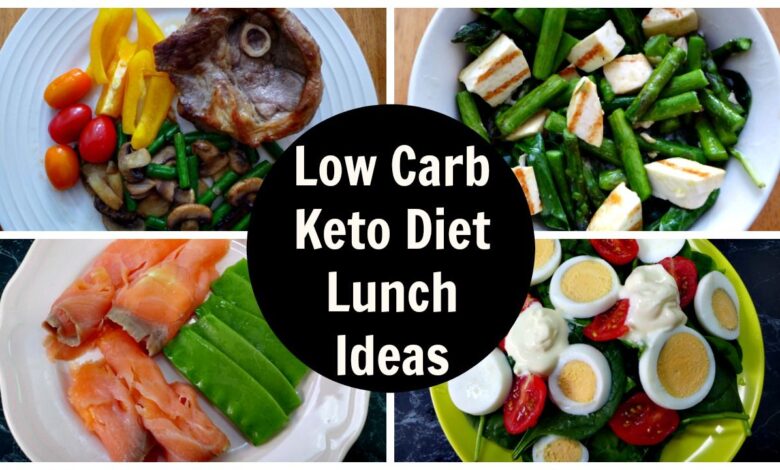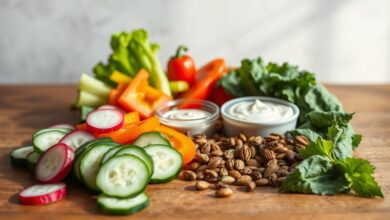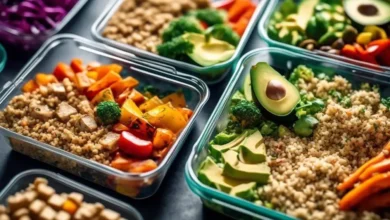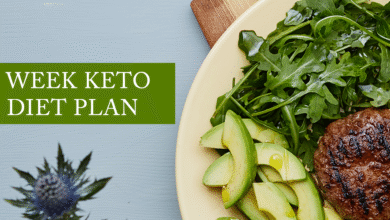
If you’re looking to lose weight, feel more energetic, and simplify your eating routine, then diving into low-carb meal prep might be your game-changer. Think of it like setting up a reliable engine for your body: choose the right fuel, plan your route, and you’ll get consistent performance. With a little strategy and some upfront effort, you’ll save time, reduce stress, and steer clear of last-minute processed food traps. Whether you’re in Accra, New York, London or anywhere in between, the principles are the same. In this guide we’ll walk you step-by-step through how to master low-carb meal prep for weight loss: from understanding why it works, to planning, shopping, cooking, storing, and staying motivated. So grab your favorite container, let’s get started!
Read Also Comprehensive Step-by-Step Guide to Low-Carb Meal Prep for Fat Loss
Why Low-Carb Meal Prep Works for Weight Loss
Meal prepping isn’t a fad—it’s a smart system. When you prepare meals ahead, you regain control over what goes into your body, you’re less tempted by impulse foods, and you save time and money. Combine that with a low-carb focus, and you’re giving your body fuel that stabilizes blood sugar, supports satiety (feeling full) and potentially encourages fat-burning. In fact, low-carb meals often feature higher protein and healthy fats, which help you stay satisfied longer, skip mid-afternoon crashes and avoid overeating. Over time, that means fewer calories without having to obsessively count them—and when you pair that with a routine of prepping ahead, you’re stacking the odds of weight-loss success in your favor.
Understanding the Basics of Carbohydrates and Why Reduce Them
Carbohydrates are one of the major macronutrients—alongside protein and fat—and they serve as quick fuel for the body. That’s fine when you’re very active and burning them fast. But for many people with busy schedules, lots of carbs (especially refined ones) lead to spikes in blood sugar, followed by crashes, cravings, and storing excess as fat. By reducing carbs—especially simple carbs—and shifting to more complex vegetables, fibre, lean protein and healthy fats, you give your metabolism more stable fuel. You’re also likely to reduce hunger swings and get clearer energy. This doesn’t mean zero carbs, but rather smart ones: leafy greens, colorful veggies, some legumes if it fits your plan, and avoiding heavy loads of white bread, sugary drinks, pastries and refined grains. When you combine this with meal prep, it becomes much easier to control portions, quality and food timing.
Setting Your Weight-Loss Goals Before You Prep
Before you dive into containers and chopping boards, it’s vital to set clear goals. Ask yourself: Where am I now? Where do I want to be? When? And why? Your “why” (better health, more energy, fitting into clothes, living longer for family) will be your fuel. Then pick a realistic target: maybe you want to lose 0.5–1 kg per week (which is safe and sustainable). Decide how many meals per week you’ll prep (maybe three dinners and two lunches). Note your current carb intake baseline: are you eating lots of white rice, bread, sugary drinks? Mark what you’ll change. Write it down. Meal prep works best when anchored in a realistic lifestyle: you’re not striving for perfection, you’re building consistency. And consistency trumps perfection every time.
**Planning Your Low-Carb Meal Prep Strategy
Choose your prep window
Select a time when you’ll do the cooking: maybe Sunday afternoon or Wednesday evening. Consistency matters—your body and mind adapt to the rhythm.
Decide how many meals you’ll prep
Are you prepping breakfasts, lunches, dinners? How many days ahead? Start with 2-3 days if you’re new; you can go five days once you’re confident.
Pick your low-carb templates
Have go-to meals that hit your macros: e.g., grilled chicken + steamed broccoli + cauliflower rice; stir-fry shrimp + zucchini noodles + mixed peppers; turkey burgers wrapped in lettuce + avocado salad.
Build a shopping list
Use your menu templates to list ingredients. Stick to whole foods primarily: lean meats, fish, eggs, leafy greens, colourful vegetables, olive oil, nuts, seeds. Add low-carb complex carbs if desired (e.g., sweet potato, quinoa in small portion).
Include seasoning and variety
Spices, herbs, marinades keep things interesting. Without flavour you’ll get bored. Think garlic, cumin, paprika, fresh chilli, lemon, basil, ginger.
Schedule storage & reheating
Do you store in the fridge or freezer? Do you need re-heat instructions? Label your containers. That extra step saves confusion and reduces food waste.
Selecting the Right Ingredients for Success
Choosing high-quality ingredients is one of the keys to meal-prep success. Lean proteins like chicken breast, turkey mince, fish (salmon, mackerel), eggs, and even plant-based proteins (tofu, tempeh) act as the foundation. For low-carb carbs: focus on vegetables like zucchini, broccoli, spinach, kale, peppers, mushrooms—these deliver nutrients without heavy starch. Healthy fats (olive oil, avocado, nuts) help with satiety and flavour. Also include herbs, spices, citrus for zest. Avoid relying heavily on processed low-carb “alternatives” (like synthetic bread-substitutes) which may still carry hidden calories or additives. In different global regions—Ghana, UK, US, EU—you’ll find different fresh produce options and price points: adapt to local markets, pick seasonal produce and lean proteins on sale. That way your meal prep is affordable, sustainable and globally adaptable.
Designing Balanced Low-Carb Meals (Macros & Portions)
One of the common mistakes is prepping low-carb meals that are unbalanced or too small (leading to hunger) or too large (leading to excess calories). You still need to hit your macros: lean protein ~25–35 g per meal, vegetables ~one large handful or more, healthy fats ~1–2 tablespoons worth. Carbs: you may aim for 30-50 g net carbs per meal (depending on how low-carb you’re going) or simply focus on keeping refined carbs minimal and letting the veggies fill you up. Portion control remains important: think of your plate as half veggies, one-quarter protein, one-quarter healthy fat/carbs. Using containers with compartments or visually mapping your plate helps. If you’re prepping for weight loss, avoid going overboard on fats even though they’re healthy—they still carry calories. Balance is the name of the game.
Meal Prep Containers, Tools & Kitchen Setup
Having the right gear facilitates your prep and increases chances of sticking to it. Look for:
- Stackable, airtight containers (glass or BPA-free plastic) with compartments if possible.
- A good set of knives and cutting board for quick prep.
- A large baking tray or sheet for roasting veggies/meats in bulk.
- Labels and markers for dates and contents (a quick glance saves confusion).
- A reliable fridge and freezer with clear zones (so you know where your prepped meals go).
- Optional: Kitchen gadgets like a spiraliser (for zucchini noodles), slow cooker, or air-fryer to speed things up.
Set aside a dedicated space for meal-prep: clear the counters, design a workflow (wash → chop → cook → portion → store). When infiltration of random stuff happens, it defeats the purpose. Think of it like prepping battle-gear before the week’s mission: you want everything lined up, ready to go.
Step-by-Step: How to Prep a Week’s Worth of Low-Carb Meals
Here’s a sample workflow you can follow:
- Pick 2 main protein types (e.g., chicken breast and salmon fillets).
- Pick 3 vegetable sides (broccoli, zucchini, mixed peppers).
- Pick 1 low-carb “carb” side if desired (cauliflower rice or sweet potato in small portion).
- On prep day: wash and chop all veggies; marinate proteins; preheat oven or grill; cook proteins and roast veggies simultaneously.
- Portion into containers: protein + veggie(s) + healthy fat (e.g., avocado slices, olive oil drizzle).
- Label each container with day & contents; store what you’ll eat in the next 2-3 days in the fridge, freeze the rest if applicable.
- Create a reheating plan: remind yourself of time/temp (e.g., microwave for 2 min, oven for 10 min).
- Monitor leftovers and waste: if you’re consistently throwing out food, adjust portions downward next week.
By following this step-by-step, you’ll eliminate “what am I going to eat?” at 5 pm, avoid fast-food temptations, and stay accountable to your weight-loss goal.
Recipe Ideas for Breakfast, Lunch and Dinner
Here’s a handful of low-carb, weight-loss-friendly meal ideas to kick things off:
- Breakfast: Kale-and-feta-omelette with spinach and mushrooms; Greek yogurt (unsweetened) with chia and berries.
- Lunch: Grilled chicken + roasted peppers + cauliflower rice; Tuna salad wrapped in lettuce leaves + avocado.
- Dinner: Baked salmon with zucchini “noodles” + lemon-garlic butter; Turkey meatballs with roasted broccoli + olive oil drizzle.
The key is simplicity and repetition with variation: once you’ve got a handful of go-to meals, you rotate them, change the flavor profiles, and you’re less likely to get bored. Check out some high-protein, low-carb recipe collections for inspiration. (Food Network)
Adapting Meal Prep for Global Audiences (US, Africa, Europe)
One of the great things about meal prep is that it’s globally adaptable. If you’re in Ghana, you might use local produce like plantain (in small portions), okra, goat meat; in the U.S., salmon, spinach, zucchini are common; in Europe, you may have access to different seasonal veggies, legumes, and specialty stores. The ingredient list stays flexible: pick local fresh foods, focus on lean protein and vegetables, and keep processed refined carbs low. Also, watch cost: in some regions, fresh fish may be expensive—substitute with eggs, lentils or cheaper lean meats. Seasonings and herbs vary culturally—embrace them (e.g., West African spice blends, Mediterranean herbs). The aim remains the same: simplify your routine and set yourself up for weight-loss success no matter where you are.
Troubleshooting Common Challenges
Boredom & flavor fatigue
Even the best meals can get dull after a few weeks. Solution: switch the herbs/spice blends, rotate proteins (fish, chicken, plant-based), vary cooking methods (grill vs bake vs stir-fry).
Time constraints
Meal prep can feel like a big time commit. Try splitting into smaller sessions: e.g., chop veggies on Sunday, cook on Monday; or cook once on Wednesday for mid-week. Use time-saving devices like air-fryer or slow cooker.
Eating out / social events
It’s OK to deviate—just re-align quickly. If you’re at a dinner, pick the lean protein and veggies, skip heavy bread/pasta, and aim to prep extra next day. Your meal-prep plan is about consistency, not perfection.
Plateaus
If weight loss stalls, check your portions and overall calorie intake (you might be eating more fat than you realize), increase non-exercise activity (walk more), assess sleep and stress (both impact metabolism). Adjust meal-prep volumes and macros accordingly.
Food safety & storage
Make sure you store prepared meals safely: refrigerate within 2 hours, keep fridge at or below 4 °C, use freezer for meals beyond 3 days, label with date, discard after 4-5 days in fridge. This prevents spoilage, food-borne illness and ensures your plan stays reliable.
Monitoring Progress and Adjusting Your Plan
It’s not enough to prep and hope for results—you also need to monitor and adjust. At least once a week, check-in:
- How many meals you stuck to from your prep schedule.
- How you felt: energy, fullness, cravings.
- Your weight (or better: body measurements or how clothes fit).
- Any leaks: times you abandoned your plan and why.
Then, adjust your prep: maybe reduce portion sizes, increase veggies, change flavours, prep fewer or more meals depending on how you’re doing. If you’re losing 0.5–1 kg per week and feeling well – great. If you’re stuck or feeling drained, you may be too low in carbs or calories, or missing key nutrients.
Adding Variety Without Sacrificing Simplicity
Variety is the spice of life, literally. But simplicity wins for consistency. To strike the balance:
- Pick 3 or 4 flavor themes per month (e.g., Mediterranean, West African, Asian stir-fry, Tex-Mex) and create meals around them.
- Stick to 5-7 core ingredients and vary one or two per week: e.g., swap chicken for turkey or tofu; broccoli for green beans; olive oil for avocado oil.
- Use spice blends to transform meals: lemon-herb, curry, smoky paprika, chili-lime.
- Rotate between cooking methods: sheet pan roast, stir fry, slow-cook, grill.
This way, you don’t reinvent the wheel every week, but you keep things interesting so you don’t abandon your plan out of boredom.
Snacks, Treats and Staying on Track
Low-carb doesn’t mean zero treats—it means smart treats. Prep snack options: hard-boiled eggs, cucumber and hummus, roasted almonds, cheese cubes, Greek yogurt with berries. When you have snacks ready, you avoid the vending-machine trap. Also plan for treat meals: one night a week you might allow a higher carb meal, or a favorite dessert in moderation. This keeps your metabolism engaged and your motivation high. The goal: a sustainable routine, not deprivation. Remember: you’re building an engine for your body, not punishing it.
Lifestyle Factors That Amplify Weight Loss
Nutrition is core—but your lifestyle matters too. Poor sleep, high stress, low physical activity all sabotage weight loss. Aim for 7–9 hours good sleep, include physical movement (walking, resistance training), hydrate well (often thirst is mistaken for hunger) and manage stress (deep breathing, meditation, social connection). These factors enhance your low-carb meal prep strategy. Think of them as engine maintenance for your body: the better the environment, the smoother the performance.
How to Scale Up or Down Your Meal Prep Over Time
As you progress, your needs change. Maybe you’ll maintain weight instead of losing; maybe you’ll train for a sport; maybe your schedule shifts. Adjust your meal-prep accordingly:
- Scale-Down: If you’re maintaining and feel fine, reduce prep from 5 to 3 meals per week, or rotate a free day.
- Scale-Up: If you’re training or want faster results, increase protein portions, include more vegetables, and perhaps prepare two-a-day meals.
- Seasonal shifts: In summer you might prefer lighter meals (salads, grilled fish); in winter more roasted root-veg and stews with lean meat.
- Budget changes: If funds are tight, pick more plant-based proteins, buy seasonal veggies, buy in bulk.
This flexibility is what makes meal prep sustainable long-term. You’re not locked in—you’re adapting.
Success Stories and Why They Matter
Hearing how others have succeeded can motivate you and give real-world proof that the system works. For example: someone in the U.S. used Sunday-meal-prep to avoid fast food on weekdays and lost 12 kg in three months; someone in Ghana swapped out heavy banku and tilapia dinners for cauliflower rice and grilled fish twice a week and noticed significant energy and weight changes; a UK professional started prepping lunches to avoid expensive take-aways and reduced both body-fat and move-in stress. These stories highlight key themes: consistency, planning, simplicity, and adaptation. You may not find one phrased exactly like your life—but you’ll recognize the pattern: choose the path, stick to it, tweak as needed, and success will come.
Maintaining Motivation and Avoiding Burn-Out
Even the best plan falters if the heart’s not in it. Here are tips to keep your motivation alive:
- Track your wins: take a photo at start, track non-scale victories (better sleep, clothes fitting).
- Celebrate small milestones: maybe buy a new container set, treat yourself to a healthy cooking gadget when you hit your target.
- Get accountability: share your plan with a friend, partner, or join an online community.
- Refresh your prep playlist: play your favorite music while you prep to make it fun.
- If you miss a day, don’t despair: one slip-up isn’t a derailment. Reset without guilt.
Think of it like tending a garden: you plant the seeds (your meal-prep), you water them (your consistency), and you occasionally clear weeds (distractions, junk food). Then you watch them grow. Your body will reward you.
Common Myths About Low-Carb Meal Prep Debunked
- Myth: Low-carb means no carbs. False. You still eat carbs; they’re just smarter carbs (vegetables, legume portions) and you avoid refined ones.
- Myth: Meal prep is only for elite athletes. No – anyone with 30 minutes and a plan can do it.
- Myth: Low-carb equals expensive. Not necessarily—by buying seasonal, using affordable proteins and cooking in bulk you can save money.
- Myth: You’ll be hungry all the time. If you eat enough protein, fat and fibre-rich veggies, you’ll be full and satisfied.
By busting these myths you’ll stay realistic and avoid frustration.
Conclusion
Meal prepping with a low-carb focus is more than just a diet trend—it’s a sustainable lifestyle framework that fits busy people across Africa, the United States, Europe and beyond. You’re setting up your week in advance, choosing high-quality fuel, and constructing a system that supports your weight-loss goal rather than fighting against it. With clear goals, smart planning, balanced macros, and supportive tools, you’re well on your way to success. Remember: consistency beats perfection. Start small, build your habit, adapt as you grow, and the results will follow. Your body will thank you—and so will your schedule. You’ve got this.
Read Also Ultimate Low-Carb Meal Prep Guide for Effective Weight Loss
FAQs
Q1: How many days in advance should I meal-prep for a low-carb plan?
A1: A good starting point is 2–4 days in advance. That way your meals stay fresh, you reduce food waste and you keep variety. As you get comfortable, you can prep for a full week if your fridge/freezer allows. The key is that you have ready meals so you’re not scrambling or resorting to less-healthy options.
Q2: Is it okay to include a small portion of rice or pasta occasionally?
A2: Yes—it’s absolutely okay. Low-carb doesn’t mean zero carbs unless you’re under strict medical advice. For weight loss and sustainable lifestyle, you can include small portions of quality carbs (like sweet potato, whole-grain pasta, brown rice) especially around activity times. Just keep portions reasonable and make your vegetables the priority.
Q3: What if I don’t like cooking or I have little kitchen space?
A3: No worries—there are workarounds. Choose very simple meal templates: baked protein + one veggie + healthy fat. Use minimal tools (oven + one tray). Cook double-batch and freeze. Or use cooking-free meals: salads with grilled pre-cooked protein, raw veggies + hummus + boiled egg. The goal is simplicity and consistency—don’t get bogged down in gourmet routines unless that’s what you enjoy.
Q4: How can I measure whether I’m making progress beyond the scale?
A4: Great question—scales are only one measure. You can track how your clothes fit, your waist/hip measurements, your energy levels, your sleep quality, how you feel mentally, your performance (stairs, workouts). Also check how many meals you stuck to your plan and whether your cravings have reduced. Progress is multi-dimensional.
Q5: Will low-carb meal prep work if I have a busy travel schedule?
A5: Yes—but you’ll need to plan for travel days. Pack portable low-carb snacks (nuts, cheese cubes, boiled eggs, veggie sticks). If you’ll be out for the day, prep a container you can carry, or identify restaurants ahead of time that offer lean protein + veggies. Even one well-planned low-carb meal when travelling keeps momentum going. The key is not perfect execution on every day—but doing more right days than wrong days.



